 October
10
October
10
Tags
Has the U.S. financial system passed the point of no return
By David Nelson, CFA
Bullet Points
- First step in solving a problem is admitting you have one
- The United States of America is addicted to debt
- Will strong earnings put our problems behind us
- Regime Change – Yields at the long end are going higher
- Problems show up in debt markets first
- Fixed income investors will demand higher yields
- House Speaker
- Washington – It’s too late for normal. We need radical change
Today, I want to cover what I think is a rising threat to the health of the U.S. financial system.
Let’s start off with the events of last Friday and what looked like a relief rally on the heels of weeks of losses. In the days prior, carnage was everywhere. Even widows and orphans weren’t safe. Dividend heavy sectors like utilities and consumer staples fell hardest, leaving many to question whether the patient was about to bleed out.

Bloomberg Data
Even in war, soldiers get time away from the front. The reprieve can last weeks, days, but often just hours. Reversion to the mean is a powerful force, and after four straight weeks of selling, any good news would have been enough to spark a rally. For days, traders have been gearing up for Friday’s jobs report with bulls hoping for a print less than 170,000 consensus and bears looking for any number hot enough to keep the Fed from taking their foot off the brake.
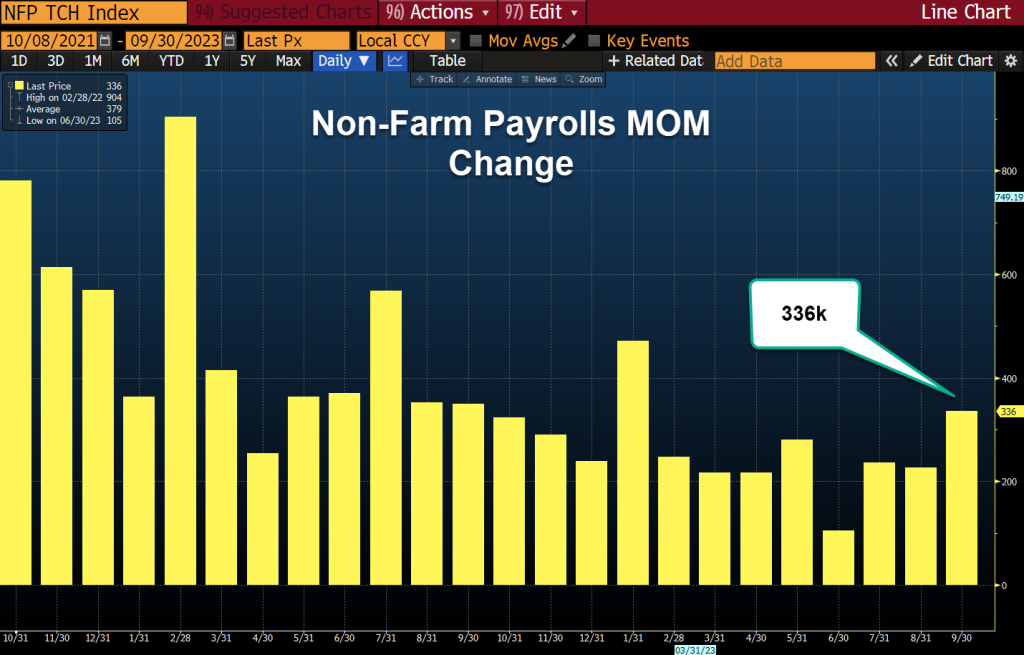
Bloomberg Data
On the surface, the 336,000 print for nonfarm payrolls was way hot and futures immediately turned south, forcing investors to gear up for another bloody battle. On Wall Street, it’s all about the spin. And Friday’s numbers gave plenty of ammunition to bulls and bears. Government jobs added were 73,000. But even if you take that number away, it was still a hot print.
The biggest gains came from leisure and hospitality coming in at 96,000, but as some talking heads noted, these tend to be lower paying jobs. All in by 11 a.m. that morning, stocks had crawled back to the flat line and never looked back.
How long will this current armistice last? I don’t know. But I suspect with Q3 earnings right on our doorstep and a war breaking out, the reprieve and volatility will be short lived.
Could a strong slate of earnings surprises put our problems behind us? Yeah, maybe. But for how long? There are still too many investors that believe the only thing holding back U.S. markets is a hawkish Federal Reserve, and that once they start to ease financial conditions, it will be off to the races.
At another point in our history, maybe that would be true. They say the first step in solving a problem is admitting you have one.
Point of no return
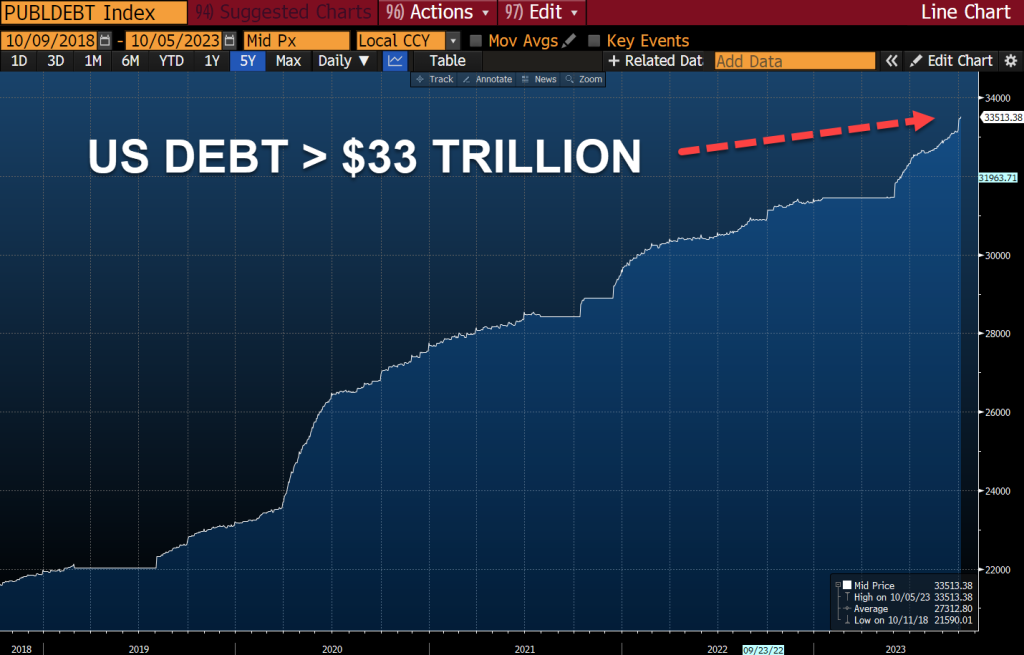
Bloomberg Data
The United States of America is addicted to debt. When used prudently, debt can be used to leverage returns, bridge a crisis, fund a war, and of course, that’s what we’ve done throughout our history.
It’s difficult to know when a drinker turns into an alcoholic or drug user turns into an addict. And it’s even more difficult to know when casual use turns into an addiction. But it is clear the US financial system has passed the point of no return. If we continue to kick this can down the road, the probabilities are grim. If not for us, our children and grandchildren.
Welcome to the Money Runner. I’m David Nelson.
What we are witnessing today is a regime change. The first data point we need to come to grips with is that a ten-year yield of 5% relative to history is completely normal. What’s not normal is the artificially induced zero interest rate policy, we’ve lived with for the last 14 years. By definition, most money managers today only know a world with low rates and are being forced to change their playbook.
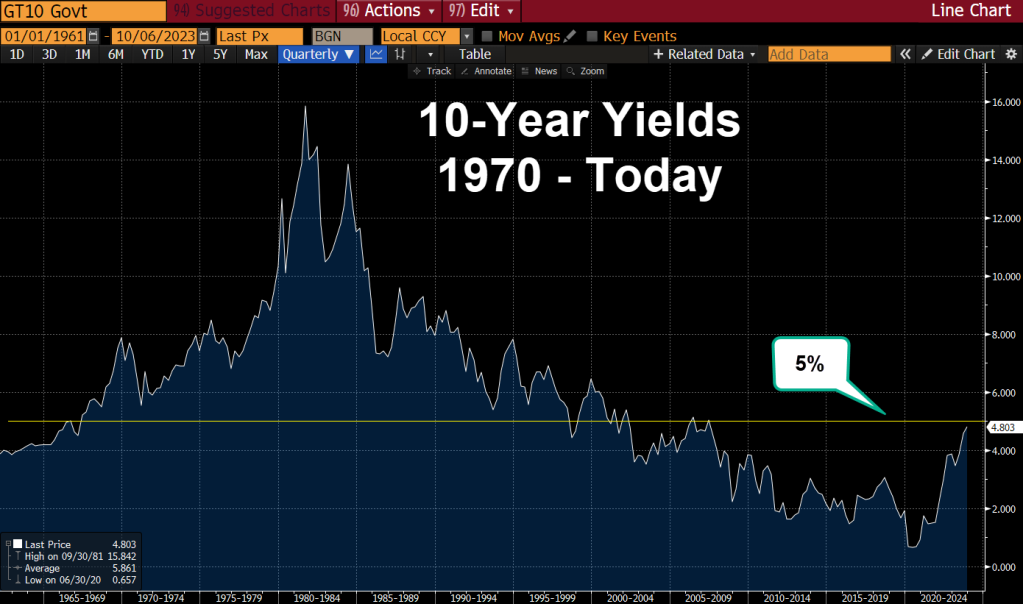
Bloomberg Data
The elephant in the room is the same elephant we’ve been living with since March of last year. Only it’s bigger, and this time it’s not about the short end of the curve, but the long end. Today’s bond markets are telling a story about the United States that is being felt from Wall Street to Main Street as rates continue to rise, despite evidence inflation has been falling since late last year.

Bloomberg Data
Sunday’s article in the Wall Street Journal goes to the heart of it, saying the autumn bond rout is challenging Wall Street’s long standing belief that the US government can’t sell too many treasuries. Well, that theory is being put to the test. Outside of COVID, the level of debt issuance by the United States is staggering. Even if the Fed cuts rates, fixed income investors will demand higher returns to extend duration. Increased supply lowers bond prices, end of story.
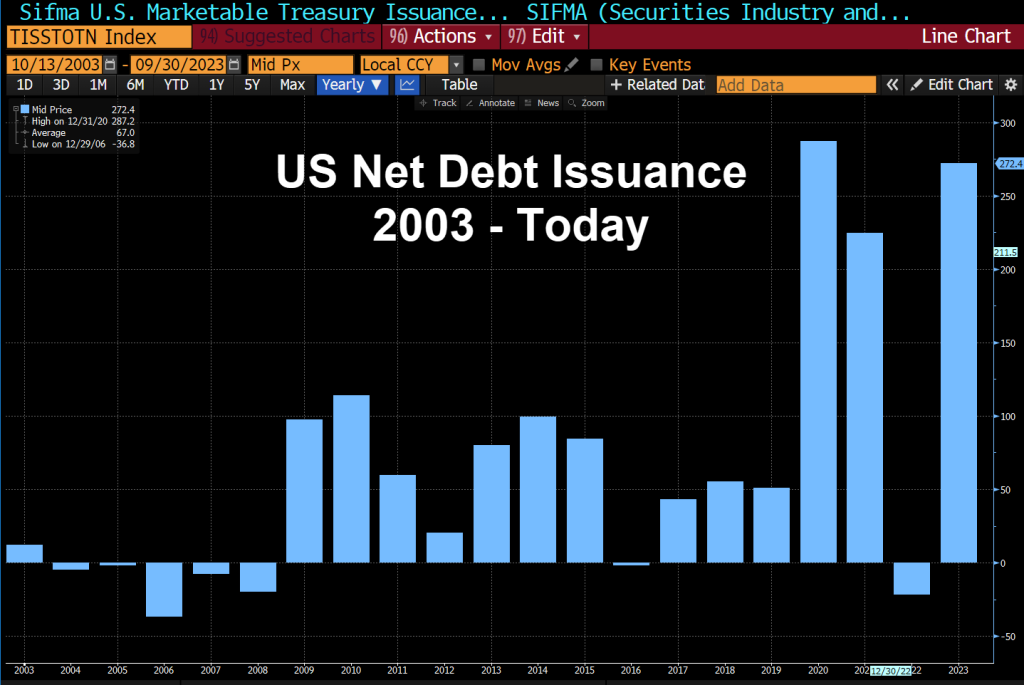
Bloomberg Data
U.S. deficits and debt continue to rise at an alarming rate with the delta or rate of change heading in the wrong direction. Washington deludes itself, believing that just because the US dollar is the reserve currency of the world, nothing can upset that advantage.

BRICS, which is Brazil, Russia, India, China, South Africa, and has now morphed into BRICS, plus includes both friends and adversaries. Five of the world’s largest oil producers are now part of the economic bloc. They seek to end the Petrodollar dependence and are now transacting business between member states in local currency.
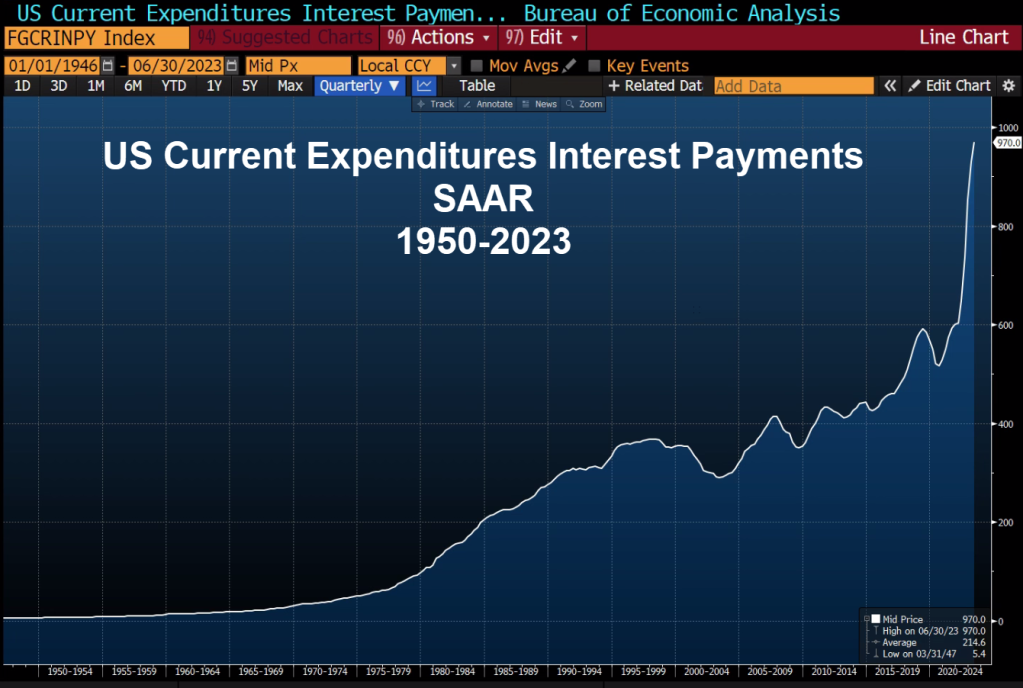
Bloomberg Data
It isn’t lost on U.S. bondholders that the cost just to service our debt will soon reach a staggering $1 trillion. It wasn’t that long ago we were running a deficit of a trillion annually, and today it’s a trillion every six months, and climbing.
Washington
Change in Washington often happens on the heels of polling data. However, as we’ve learned from past election cycles, polls are often wrong, and even more concerning is that the data can be manipulated by how you ask the questions. When you question voters with a phone survey, you may get answers telling you what you want to hear. The mood of the day, their personal biases all color and taint the information. The very questions that are asked and how they’re phrased can tilt the results to a pre desired outcome.
When people back up what they say with cold, hard cash, the overriding message or sentiment is likely closer to the truth. Financial markets take in all available information, pricing assets based on hundreds of metrics including earnings, cash flows, dividends, interest, liquidity and of course, risk.

Bloomberg Data
After surviving the dot com bubble, the recession of 2001, the financial crisis, COVID and a debt crash in 2022, I’ve concluded that most problems first surface in bond markets. Equity investors get caught up in the story and excitement of a product, service or technology.
Fixed income traders focus on what’s important. How much are you going to pay me to lend you the money? And what are the odds you’ll pay it back? That’s it. The rest is just noise.
Politicians would have a better understanding of the world around them if they would listen more to markets and less to polls and focus groups.
Approval Ratings
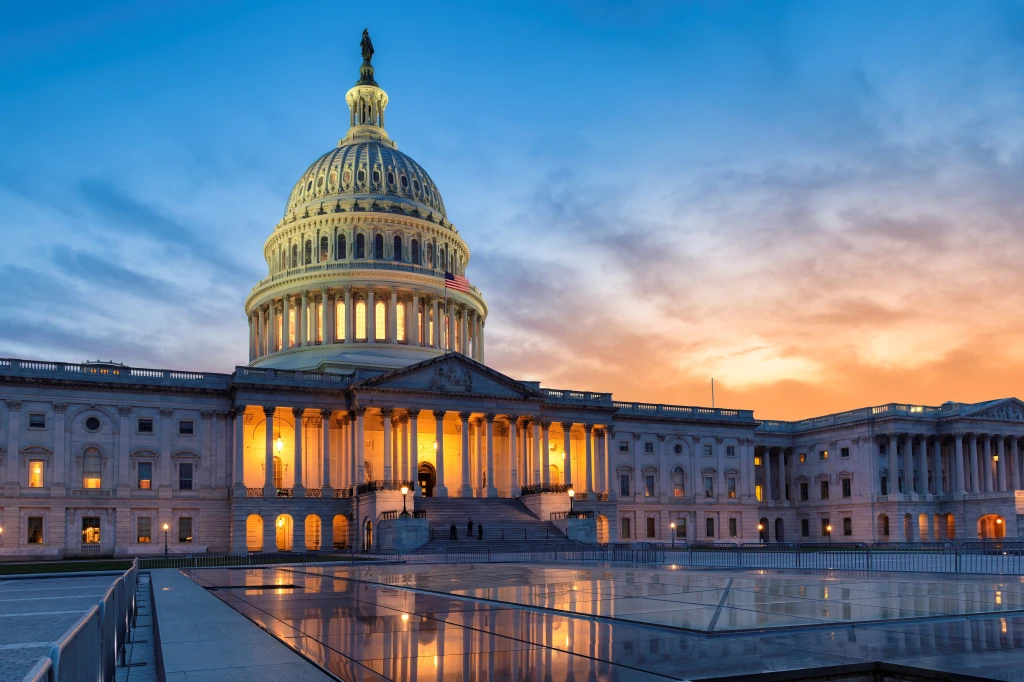
The only part of the government with a lower approval rating than both Biden and Trump is Congress. Why? Because they don’t do their job. The last time Congress passed a budget on time was 20 years ago.
In overwhelming numbers, Americans believe their government has let them down, failing at some of the basic tasks of any government body. Any rational view of good government would have to include the following: A government that is accountable to the people, not to special interests, corporate interests, or the self-interest of elected or appointed officials.
Does that sound like the current system?
Americans on both sides of the aisle are incensed at a Washington revolving door that permits government officials to take jobs in retirement with the very institutions and corporations they regulated while in service. The potential for abuse is obvious.
 Earmarks or special interest projects are back in Washington, and both sides of the aisle are fighting for their share of the pork. Former South Carolina Governor Nikki Haley criticized the GOP earmarks during the Republican presidential debate in August. According to the Citizens Against Government Waste, there were 7396 earmarks for 2023, up a staggering 43%. With deficits and debts ballooning, the last thing we need are more bridges to nowhere.
Earmarks or special interest projects are back in Washington, and both sides of the aisle are fighting for their share of the pork. Former South Carolina Governor Nikki Haley criticized the GOP earmarks during the Republican presidential debate in August. According to the Citizens Against Government Waste, there were 7396 earmarks for 2023, up a staggering 43%. With deficits and debts ballooning, the last thing we need are more bridges to nowhere.
Last week’s removal of Kevin McCarthy as House speaker exposed the divide within the Republican Party. The fractures are deep and countered by Democrats that generally conduct business in lockstep.
The House is supposed to pass individual appropriation bills where at least there is an opportunity to address them on their merits and remove wasteful parts of the legislation. We can no longer accept endless continuing resolutions that delay the inevitable, usually ending in a monstrous omnibus bill, with all the appropriations slammed together, producing a 4000 page document that few will read but most will pass.
There is a rising voice in America that says it is too late for normal and anything less than radical change is unacceptable. I am one of those voices.